
Bonsai is a Japanese art form which utilizes cultivation techniques to produce, in containers, small trees that mimic the shape and scale of full size trees. Similar practices exist in other cultures, including the Chinese tradition of penzai or penjing from which the art originated, and the miniature living landscapes of Vietnamese Hòn non bộ. The Japanese tradition dates back over a thousand years.

Ficus benghalensis, commonly known as the banyan, banyan fig and Indian banyan, is a tree native to the Indian Subcontinent. Specimens in India are among the largest trees in the world by canopy coverage.
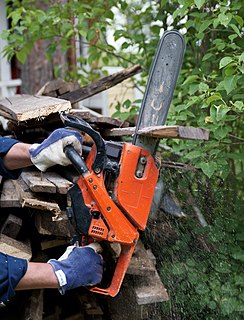
A chainsaw is a portable, mechanical saw which cuts with a set of teeth attached to a rotating chain that runs along a guide bar. It is used in activities such as tree felling, limbing, bucking, pruning, cutting firebreaks in wildland fire suppression and harvesting of firewood. Chainsaws with specially designed bar and chain combinations have been developed as tools for use in chainsaw art and chainsaw mills. These specialized chainsaws are used for cutting concrete during construction developments. Chainsaws are sometimes used for cutting ice, for example, ice sculpture and winter swimming in Finland. Someone who uses a saw is a sawyer.
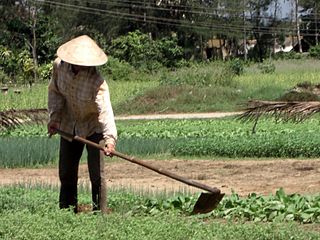
A hoe is an ancient and versatile agricultural and horticultural hand tool used to shape soil, remove weeds, clear soil, and harvest root crops. Shaping the soil includes piling soil around the base of plants (hilling), digging narrow furrows (drills) and shallow trenches for planting seeds or bulbs. Weeding with a hoe includes agitating the surface of the soil or cutting foliage from roots, and clearing soil of old roots and crop residues. Hoes for digging and moving soil are used to harvest root crops such as potatoes.
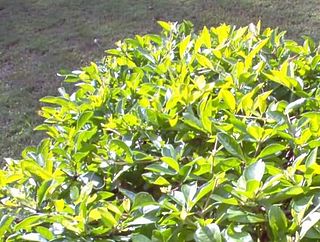
Pruning is a horticultural and silvicultural practice involving the selective removal of certain parts of a plant, such as branches, buds, or roots. Reasons to prune plants include deadwood removal, shaping, improving or sustaining health, reducing risk from falling branches, preparing nursery specimens for transplanting, and both harvesting and increasing the yield or quality of flowers and fruits.

The genus Tamarix is composed of about 50–60 species of flowering plants in the family Tamaricaceae, native to drier areas of Eurasia and Africa. The generic name originated in Latin and may refer to the Tamaris River in Hispania Tarraconensis (Spain).

A garden centre is a retail operation that sells plants and related products for the domestic garden as its primary business.

The Pulaski is a special hand tool used in fighting wildfires which combines an axe and an adze in one head. Similar to a cutter mattock, it has a rigid handle of wood, plastic, or fiberglass. The Pulaski is used for constructing firebreaks, able to both dig soil and chop wood. It is also well adapted for trail construction, and can be used for gardening and other outdoor work for general excavation and digging holes in root-bound or hard soil. The axe blade of the Pulaski is the primary cutting edge, while the adze blade is secondary; this is the opposite of the cutter mattock, in which the adze blade is the larger of the two.

The Mother Orange Tree is the oldest living orange tree in Northern California. The California Historical Landmark is located at 400 Glen Drive in Oroville, California.

Acacia melanoxylon, commonly known as the Australian blackwood, is an Acacia species native in South eastern Australia. The species is also known as Blackwood, hickory, mudgerabah, Tasmanian blackwood, or blackwood acacia.

A hedge trimmer, shrub trimmer, or bush trimmer is a gardening tool or machine used for trimming hedges or solitary shrubs (bushes). Different designs as well as manual and powered versions of hedge trimmers exist.

Grevillea miniata, commonly known as the sandstone grevillea, is a shrub or small tree between 1.8 and 5 metres in height which is native to Western Australia and the Northern Territory. It has yellow or orange flowers and holly-like leaves.

Ulmus mexicana(Liebm.) Planch., the Mexican elm, is a large tree endemic to Mexico and Central America. It is most commonly found in cloud forest and the higher elevations (800–2200 m) of tropical rain forest with precipitation levels of 2–4 m per year, ranging from San Luis Potosi south to Chiapas in Mexico, and from Guatemala to Panama beyond. The tree was first described botanically in 1873.

Grafting or graftage is a horticultural technique whereby tissues of plants are joined so as to continue their growth together. The upper part of the combined plant is called the scion while the lower part is called the rootstock. The success of this joining requires that the vascular tissues grow together and such joining is called inosculation. The technique is most commonly used in asexual propagation of commercially grown plants for the horticultural and agricultural trades.
Grevillea decurrens, also known as the clothes-peg tree, is a shrub native to northern Australia. It was described in 1917 by Alfred J. Ewart, having been considered a pink-flowered variant of the similar Grevillea heliosperma.
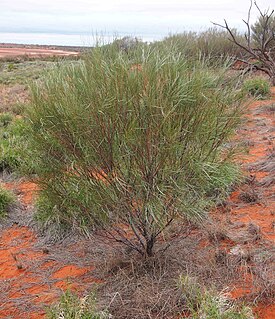
Grevillea juncifolia, commonly known as the honeysuckle grevillea, honey grevillea and honeysuckle spider flower, is a shrub or small tree species that is native to inland Australia. It grows to between 2 and 7 metres high. The yellow or orange flowers appear all your round, peaking between July and November in the species' native range.
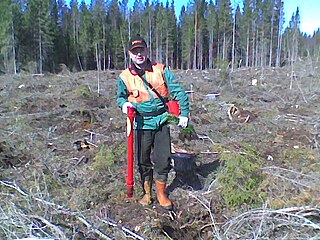
Pottiputki is a planting tool that was created by Tapio Saarenketo in the early 1970s, used for manual planting of containerized seedlings. The planters can work in an ergonomically correct position while maintaining high productivity, making the task both fast and comfortable. It is more effective, but more expensive than the traditional mattock.
Grevillea glauca, commonly known as bushman's clothes peg, cobblers peg tree or the beefwood tree, is a shrub or small tree that is native to Papua New Guinea and north-eastern Queensland, Australia. It usually grows to a height of between 2 and 10 metres and has leaves that are 6 to 20 cm long and 1 to 6.5 cm wide. Flowers are cream or greenish white and appear between April and August in the species' native range. These are followed by rounded follicles that are 2.4 to 4 cm long.
i-Tree is a collection of urban and rural forestry analysis and benefits assessment tools. It was designed and developed by the United States Forest Service to quantify and value ecosystem services provided by trees including pollution removal, carbon sequestration, avoided carbon emissions, avoided stormwater runoff, and more. i-Tree provides baseline data so that the growth of trees can be followed over time, and is used for planning purposes. Different tools within the i-Tree Suite use different types of inputs and provide different kinds of reports; some tools use a 'bottom up' approach based on tree inventories on the ground, while other tools use a 'top down' approach based on remote sensing data. i-Tree is peer-reviewed and has a process of ongoing collaboration to improve it.
Grevillea dimidiata, also known as the caustic bush or willings tree, is a small tree or shrub which is endemic to Australia.

















